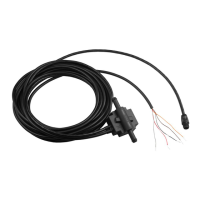September 2008 Part Number 190-00884-01 Rev. A Printed in Taiwan
GFS
™
10 Sensor Conguration Guide
See the Important Safety and Product Information guide in the product box for product warnings and
other important information.
The GFS 10 provides fuel-ow (volume/time) information for various screens, data elds,
or digital gauges of NMEA 2000
®
-compatible and Garmin
®
CANet
®
-compatible connected
display devices. For a list of compatible Garmin chartplotters and devices, visit
www.garmin.com.
Important: This document provides specic conguration information for the GFS 10
using your NMEA 2000-compatible or Garmin CANet-compatible display device (such as
a GMI
™
10 or GPSMAP
®
545). To access the NMEA 2000 or CANet device conguration
menu on your display device, consult the documentation provided with your display
device.
CAUTION: The GFS 10 is a sensor that helps you better determine the amount of fuel
used on your boat, and you should not rely solely on the GFS 10 for fuel-level information.
Carefully compare information displayed on the unit to all available fuel-level instruments
and sources.
Troubleshooting Fuel Gauge Type
When wired to a fuel gauge, the gauge type defaults to Auto Detect. If the fuel-level
reading on your Garmin chartplotter or marine instrument changes with the engine RPM,
the GFS 10 could be detecting the wrong type of gauge.
NOTE: The fuel level changes with the motion of the boat. Perform this test when the boat is
not moving.
To test the gauge-type setting:
1. When the boat is not moving, put the engine in neutral.
2. Use the throttle to increase the engine RPM. If the fuel-level reading changes with the
engine RPM, change the gauge type.
To change the gauge-type setting:
1. WhileviewingtheNMEA2000ortheCANetdevicecongurationmenu,selectthe
GFS 10 device.
2. Select Cong > Gauge Type.
3. Choose 1 Coil or 2 Coil and repeat the gauge-type setting test.
Troubleshooting the Fuel-Flow Rate
If the fuel-ow information received from the GFS 10 appears inaccurate, you can
manually adjust the fuel-ow reading.
To adjust the fuel-ow rate:
1. WhileviewingtheNMEA2000ortheCANetdevicecongurationmenu,selectthe
GFS 10 device.
2. Select Cong > Flow Adjustment.
3. Enter a positive or negative adjustment.
EXAMPLE: When you set the Flow Adjustment to +10% , a ow reading of 20 gal./hr.
(75 l/h) would change to a reading of 22 gal./hr. (82.5 l/h), because 20 gal. × 110% = 22 gal.
(75 l × 110% = 82.5 l).
Restoring Factory Default Settings
You can restore factory default settings to the GFS 10. You will lose all custom
conguration and calibration settings when you restore factory default settings.
To restore factory default settings:
1. WhileviewingtheNMEA2000ortheCANetdevicecongurationmenu,selectthe
GFS 10 device.
2. Select Cong > Factory Defaults.

